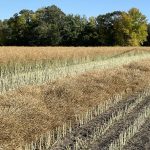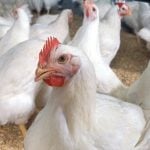It might be herbicide tolerant, but it isn’t drought resistant.
The Roundup Ready wheat in the Monsanto research plot east of Saskatoon looked as stressed as other area crops.
Company researchers said they were considering trucking in water to irrigate the small plots that are mainly designed to study various weed control regimes.
The drought is just one of the challenges faced by this new genetically modified crop.
Monsanto officials recently outlined the regulatory and safeguard processes they are engaged in as they push toward their goal of commercially releasing the herbicide-tolerant wheat by spring 2004 or 2005.
Read Also

Moe shares goals for Chinese trade mission
To advocate on behalf of Saskatchewan agriculture and other industries, as well as the Canadian canola, pork, pulse, and seafood industries, Saskatchewan Premier, Scott Moe, is travelling to China on a trade mission.
“To our knowledge, we are the only company that has ever put this kind of due diligence into this kind of work,” said Carman Read with Monsanto’s industry affairs department.
The company insists it will not commercialize the crop until it is sure there is a market for it.
But in the meantime, it is doing the research needed to provide regulators with information to get approvals and registrations for growing and consuming in its primary target markets – Canada, the United States and Japan.
Also, the company has paid Agriculture Canada and university researchers to find the best agronomic management practices to recommend with the new crop. For example, it is studying ways to control volunteer Roundup Ready wheat in Roundup Ready canola.
Monsanto is concentrating on Roundup Ready wheat varieties identified as BW 251 and BW 252.
They are hard red spring wheat crosses of Grandin and AC Domain developed by Agriculture Canada.
BW 252 without the herbicide-tolerant gene has already been registered and will be sold by Secan under the name AC Superb. Co-op trials indicate it is 15 percent higher yielding than current industry standard AC Barrie. It is shorter than Barrie, has stronger straw and is more rust resistant, but it is two days later in maturity.
The company thinks the strong variety will be much enhanced when grown in conjunction with its glyphosate herbicide Roundup.
Read said the company is also developing another herbicide to replace Roundup in preseeding burndown so the glyphosate can be saved for use on the crop.
Monsanto believes the package will allow the crop to develop with less weed pressure than under existing herbicide packages. This is expected to give the crop more uniformity and allow it to better use soil nutrients to produce better quality grain.
The company hopes the quality will attract millers to the GM wheat.
Curtis Rempel, with Monsanto’s commercial development department, said the company plans to launch the product under an identity preserved system simultaneously in Canada and the United States.
“This is not going to be a broad-based launch of technology. It will be a managed launch where we have … supply lining up with demand,” he said.
There will also have to be a viable and internationally acceptable method of testing for GM material in wheat and internationally accepted tolerances for GM content.
Without this, the Canadian wheat industry could be put at risk.
“And we don’t want to be the company doing that,” Rempel said.
“So we have a dialogue work to do and a lot information to provide to the international milling and baking community.”














